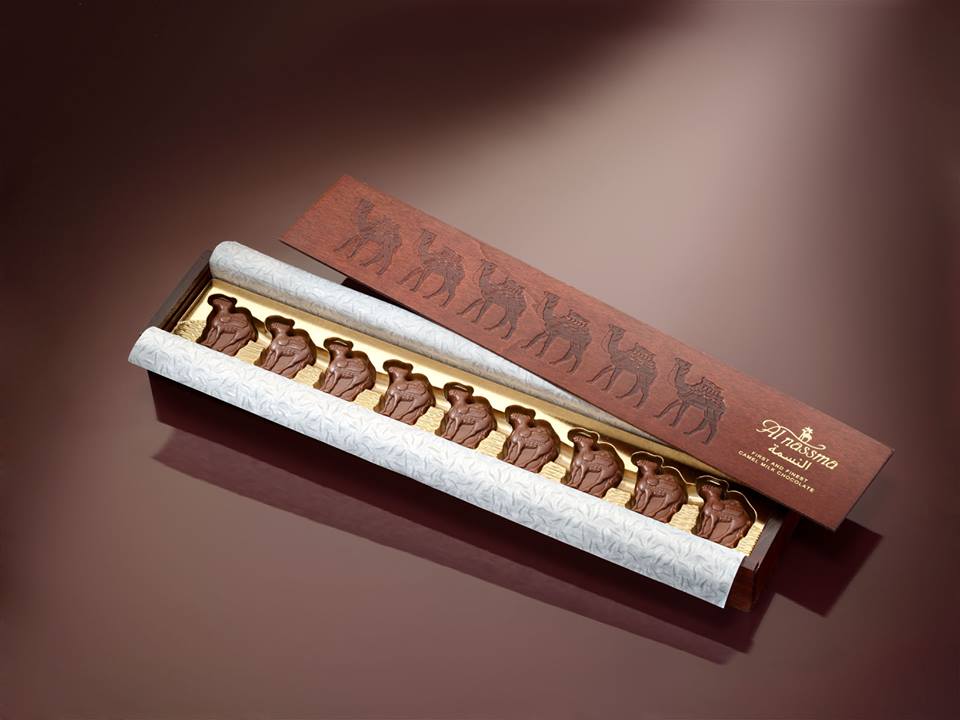Dubai – Behind the doors of one of the plants in the Dubai Oasis Silicon free zone, the smell is pleasant and inviting. A machine mixes up the dark bright liquid that’ll turn to chocolate. In another piece of equipment, the dried brown paste sits in molds that gyrate in the air, and hands set the tablets into golden wrappings. This would otherwise just be a neat, well-equipped fine chocolate factory, weren’t it for the main ingredient: camel milk.
Al Nassma is an UAE-based company that’s taking to the world with a product that combines local tradition – camel milk – and the luxury that typifies the lives of locals and tourists alike here. The company’s manufacturing unit puts out some 100 tons per year of camel milk chocolate. The milk comes from a 6,000-camel farm about 15 km away from the plant.
The chocolates are mostly carried by airport shops, from where they fly across borders in the luggage of Asians, Europeans, Americans and anyone looking to leave the Middle East with something that symbolizes the region. Who wouldn’t like to step off a homebound flight from Dubai with a sophisticated gift made with milk from a desert animal which embodies Bedouin life and is a part of local history?
ANBA made a visit to the Al Nassma plant and spoke with general manager Martin van Almsick (pictured above), a non-local who’s a chocolate aficionado. “When we started, ten years ago, not everybody was convinced that that was a good idea, to sell camel milk chocolates,” he says. But there was government-owned farm with milk available, and chocolate people who were willing to give it a go. That’s how Al Nassma came into being.
Martin explains that no one was making camel milk chocolate before Al Nassma came into the picture. “Camel milk has been here for centuries, and people here, they know about the special values and properties of camel milk. It’s a very healthy milk. And then chocolate people came, you know, and people start to talk, and this is how ideas are generated,” he says. The expertise on what the camel milk had to be like for chocolate-making and the actual manufacturing were developed by the company.
Production doesn’t seem that secretive. One big machine combines the ingredients, and then the mix gets poured into different molds. Another piece of equipment spins the molds to dry out the chocolate. A machine detects impurities, the product gets refrigerated and the content of the molds gets adjusted for a smooth tablet, among other processes.
There are lots of humans on hand at the plant. They’ll cut dates into strips for the filling of some of the chocolates, pack and box up the product, etc. Martin explains that the team is multinational, with people from India, Sudan, Indonesia, Ethiopia, Kenya, Germany. Martin himself is from Germany, and he walks through the plant speaking amicably with the staff.
(story continues after photo gallery)
Al Nassam product comes in various shapes – tablets, camels, bonbon-like pieces in assorted packages. The easiest to find in UAE airports are square-shaped boxes whose texture mimics camel skin, with nine or 18 small chocolates inside. Everything is premium – the tablets and boxes come wrapped in fine, bright paper. The inside (and some of the outside) of the boxes is golden, and a brown ribbon gives the final touch.
Tablets, the most affordable option, go for about USD 7 in Dubai retail. The most expensive one is an 18-chocolate wooden box with flavors including macadamia, honey and cream, and pure milk. “It’s a real royal gift. If you want to impress your mother-in-law, this is the thing you would choose,” quips Martin. The general manager argues that Al Nassma chocolate is affordable, even though it’s a special product. “It’s not for every day. It’s for Sunday, or for Friday,” he says. The weekend in the UAE begins on Friday.
Al Nassma sells mostly through travel retain – duty frees – and from gourmet shops, high-end points of sale. The biggest market for the company is the Middle East – the airports in Abu Dhabi, Dubai and Sharjah, Muscat (Oman), Saudi Arabia. But the brand is also available in Arab countries like Morocco and Egypt and elsewhere in the world: the European Union, Japan, China and the United States.
The only way Al Nassma chocolates get into Brazil are through people who buy them in other countries, but the company is looking to start selling in the country. “What we need is a partner who really understands our story, who really understands the quality of our chocolate and why it’s special,” says Martin, explaining that the product must be sold in premium shops alongside high-end olives, specialty coffees, etc. The manager says there’s no rush when it comes to selling in Brazil, and that the most important thing is finding a partner who understands the product and has the right, chocolate-loving customers.
Al Nassma is a member of foreign sales-oriented organization Dubai Exports, which is working via its São Paulo office to place the brand’s products in Brazil. The chocolates have been showcased at supermarket industry expo Apas Show.
Al Nassam camel milk chocolate does not contain oils or chemicals. It’s all-natural, according to Martin. It tastes different than cow milk chocolate – since camel milk has half the fat content. It’s also saltier, and this reflects on the chocolate’s flavor. “People who know a little bit about chocolate, they find this is a high quality, premium product,” says the general manager.
Quick facts
Al Nassma
Website: http://www.al-nasma.com/
Phone: + 971 4 223 9289
Email: office@al-nassma.com
Dubai Exports
Website: http://www.dedc.gov.ae/English/Pages/default.aspx
Phone: +55 (11) 40636066
Email: oto.saopaolo@dedc.gov.ae
Translated by Gabriel Pomerancblum













